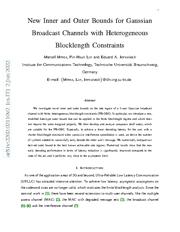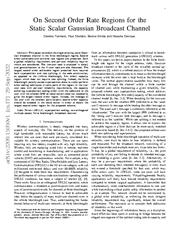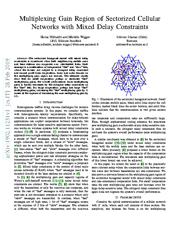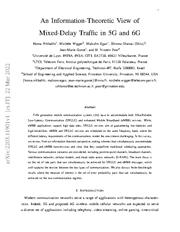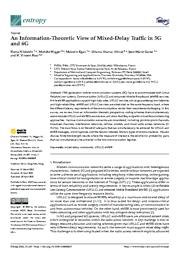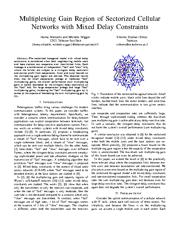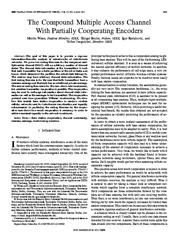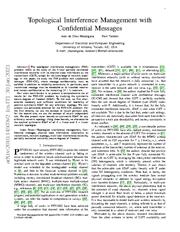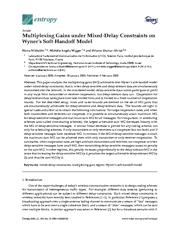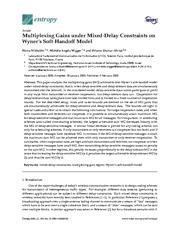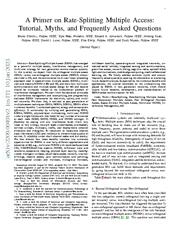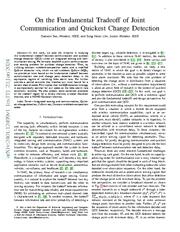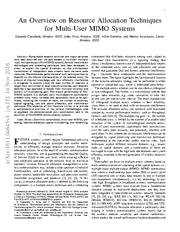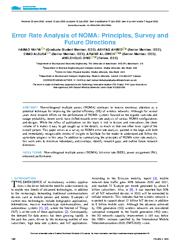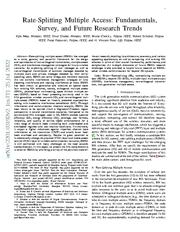A copy of this work was available on the public web and has been preserved in the Wayback Machine. The capture dates from 2022; you can also visit the original URL.
The file type is application/pdf.
Filters
New Inner and Outer Bounds for Gaussian Broadcast Channels with Heterogeneous Blocklength Constraints
[article]
2022
arXiv
pre-print
We investigate novel inner and outer bounds on the rate region of a 2-user Gaussian broadcast channel with finite, heterogeneous blocklength constraints (HB-GBC). ...
Especially, to achieve a lower decoding latency for the user with a shorter blocklength constraint when successive interference cancellation is used, we derive the number of symbols needed to successfully ...
System Model We consider a two-user Gaussian broadcast channel with heterogeneous blocklength constraints (HB-GBC) and quasi-static block flat-fading. ...
arXiv:2202.02110v2
fatcat:l4d6toglgzdwdjcoy5bamvh2oe
On Second Order Rate Regions for the Static Scalar Gaussian Broadcast Channel
[article]
2022
arXiv
pre-print
This paper considers the single antenna, static Gaussian broadcast channel in the finite blocklength regime. Second order achievable and converse rate regions are presented. ...
Instead, the message of the user with the smallest point-to-point second order capacity should be encoded in the cloud center in order to obtain the largest second order region for the proposed scheme. ...
In [20] , the two-user AWGN BC with heterogeneous blocklengths was considered; our work with global error is the special case where the two blocklengths are the same, yet our construction produces a larger ...
arXiv:2209.15050v1
fatcat:wuz35clvkzhtnfmiazhjl2xtgi
Multiplexing Gain Region of Sectorized Cellular Networks with Mixed Delay Constraints
[article]
2019
arXiv
pre-print
Inner and outer bounds on the multiplexing gain region are derived. ...
The sectorized hexagonal model with mixed delay constraints is considered when both neighbouring mobile users and base stations can cooperate over rate-limited links. ...
Inner and outer bounds on the multiplexing gain region are illustrated in Figure 2 . ...
arXiv:1902.11231v1
fatcat:34rpvrd3fra3tira7yb3hw3pue
An Information-Theoretic View of Mixed-Delay Traffic in 5G and 6G
[article]
2022
arXiv
pre-print
Various communication scenarios are considered, including point-to-point channels, broadcast channels, interference networks, cellular models, and cloud radio access networks (C-RANs). ...
The main focus is on the set of rate pairs that can simultaneously be achieved for URLLC and eMBB messages, which well captures the tension between the two types of communications. ...
R (U) R (e) Outer, Inner, σ 2 F = 0.2, σ 2 G = 4 Outer, Inner, σ 2 F = 0.3, σ 2 G = 4 Outer, Inner, F = 3, G = 60 Fig. 16 : Inner and outer bounds on the achievable R (U) and R (e) rate region presented ...
arXiv:2203.11901v1
fatcat:thmdwxwgebfdhn6je4y5axoyt4
An Information-Theoretic View of Mixed-Delay Traffic in 5G and 6G
2022
Entropy
Various communication scenarios are considered, including point-to-point channels, broadcast channels, interference networks, cellular models, and cloud radio access networks (C-RANs). ...
The main focus is on the set of rate pairs that can simultaneously be achieved for URLLC and eMBB messages, which captures well the tension between the two types of communications. ...
Outer and Inner Bounds, D = ∞ Outer Bound D = 10, M = 1 Inner Bound, D = 10, M = 1.01 Outer Bound D = 4, M = 1 Inner Bound, D = 4, M = 1.08 (b) ρ f = 0.3. ...
doi:10.3390/e24050637
pmid:35626522
pmcid:PMC9141450
fatcat:vl6xejfxqbdgdb7wfzok55shoq
Multiplexing Gain Region of Sectorized Cellular Networks with Mixed Delay Constraints
2019
Zenodo
The 20th IEEE International Workshop on Signal Processing Advances in Wireless Communications (SPAWC2019), 2-5 July 2019, Cannes France. ...
Inner and outer bounds on the multiplexing gain region are illustrated in Figure 2 . ...
INTRODUCTION Heterogenous traffics bring various challenges for modern communication systems. In this paper, we consider traffics with heterogeneous latency requirements. ...
doi:10.5281/zenodo.3528028
fatcat:3aqrqffwvjggjiawhskjmgskuq
The Compound Multiple Access Channel With Partially Cooperating Encoders
2011
IEEE Transactions on Information Theory
We prove two coding theorems for the compound multiple-access channel (MAC) with an arbitrary number of channel states. ...
The receiver may have arbitrary channel state information. The first coding theorem is for the case that both transmitters have a common message and that each has an additional private message. ...
For the Gaussian -interference channel, outer and inner bounds to the capacity region where the decoders can exchange information about the channel outputs are provided in [7] . ...
doi:10.1109/tit.2011.2119830
fatcat:o5fr4zwo35g4haoisjdhabzjzy
Topological Interference Management with Confidential Messages
[article]
2023
arXiv
pre-print
We also present outer bounds on symmetric SDoF for any arbitrary network topology. Using these bounds, we characterize the optimal symmetric SDoF of all K=2-user and K=3-user network topologies. ...
The topological interference management (TIM) problem refers to the study of the K-user partially connected interference networks with no channel state information at the transmitters (CSIT), except for ...
Wyner's model was extended to the nondegraded wiretap channel in [9] , and then to the Gaussian wiretap channel in [20] . ...
arXiv:2010.14503v2
fatcat:7satewis7fg7hatmq2fpo6hwz4
Multiplexing Gains under Mixed-Delay Constraints on Wyner's Soft-Handoff Model
2020
Entropy
For the described setup, inner and outer bounds are derived on the set of MG pairs that are simultaneously achievable for delay-sensitive and delay-tolerant data. ...
The bounds are tight in special cases and allow us to obtain the following conclusions. ...
A similar approach was taken in Reference [2] but for a broadcast scenario with K users. ...
doi:10.3390/e22020182
pmid:33285957
fatcat:mnsquc4gufhw3c2xq5drylcnuu
Multiplexing Gains under Mixed-Delay Constraints on Wyner's Soft-Handoff Model
2020
Zenodo
Entropy 2020, 22(2), 182; https://doi.org/10.3390/e22020182 (This article belongs to the Special Issue Wireless Networks: Information Theoretic Perspectives) ...
A similar approach was taken in Reference [2] but for a broadcast scenario with K users. ...
Our inner bound for D Rx = 5 and D Tx = 5 contains all other inner bounds and it matches the outer bound in the regime S (F) ≤ L · 2(1−α 1 )+α 1 ·(D+1) 2D+2 , where for the definition of α 1 in (35) one ...
doi:10.5281/zenodo.3648202
fatcat:dliuzxmcujavhctg6pam6vpksu
A Primer on Rate-Splitting Multiple Access: Tutorial, Myths, and Frequently Asked Questions
[article]
2023
arXiv
pre-print
in space-division multiple access (SDMA), multi-user and massive MIMO in 4G and 5G, and show how multi-user communications and multiple access design for 6G and beyond should be intimately related to the ...
Rate-Splitting Multiple Access (RSMA) has emerged as a powerful multiple access, interference management, and multi-user strategy for next generation communication systems. ...
As we know, Gaussian signaling is the optimal signaling in many channels, e.g., point-to-point Gaussian channels, Gaussian multiple access channels, and Gaussian broadcast channels. ...
arXiv:2209.00491v2
fatcat:rr7krs46jjdlvjdviyxyafcj6i
On the Fundamental Tradeoff of Joint Communication and Quickest Change Detection
[article]
2024
arXiv
pre-print
We also present some canonical examples of the tradeoff region for a binary channel, a scalar Gaussian channel, and a MIMO Gaussian channel. ...
We further provide a partial converse that matches our inner bound for a certain class of codes. ...
Nonetheless, several important open problems are still due, for instance, a tighter inner bound and a generic outer bound for all possible codes on the region R. ...
arXiv:2401.12499v1
fatcat:qztps35wnre6xdigba3653pjjm
An Overview on Resource Allocation Techniques for Multi-User MIMO Systems
2017
IEEE Communications Surveys and Tutorials
The achievable performance of such techniques heavily depends on the channel characteristics of the selected users, the amount of channel knowledge, and how efficiently interference is mitigated. ...
The overall performance of MU-MIMO systems is a complex joint multi-objective optimization problem since many variables and parameters have to be optimized, including the number of users, the number of ...
CSI case. 2) Indirect Approach: In this approach, the inner and outer problems in (8) are decoupled. ...
doi:10.1109/comst.2016.2618870
fatcat:7kehhw6eibc7dfsjyovsf3t6ia
Error Rate Analysis of NOMA: Principles, Survey and Future Directions
2023
Zenodo
This paper serves as a survey on NOMA error rate analysis, painted in the large with bold and immediately recognizable strokes of insights to facilitate for the reader to understand and follow the up-to-date ...
In addition to summarizing the principles of NOMA error rate analysis, this work aims to minimize redundancy and overlaps, identify research gaps, and outline future research directions. ...
For example, the authors of [55] used the union bound for the outer integration and exponential bound for the inner integration. ...
doi:10.5281/zenodo.8329120
fatcat:qmrhbrne7bg2rp77ctf6ktgffq
Rate-Splitting Multiple Access: Fundamentals, Survey, and Future Research Trends
[article]
2022
arXiv
pre-print
a wide range of network loads (including both underloaded and overloaded regimes) and user channel conditions. ...
Compared to the conventional MA strategies used in 5G, RSMA enables spectral efficiency (SE), energy efficiency (EE), coverage, user fairness, reliability, and quality of service (QoS) enhancements for ...
[85] 2-user SISO BC with cooper- Perfect CSIT Rate region Showed that RS achieves an inner bound on the capacity region ative relaying of the two-user SISO BC with cooperative relaying. 2008 [21] 2-cell ...
arXiv:2201.03192v2
fatcat:z3ujjbqwxzc5dbgu3ganoqomae
« Previous
Showing results 1 — 15 out of 28 results

